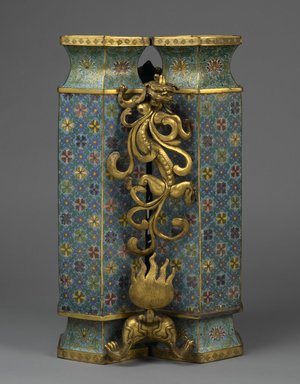
Medium: Cloisonné enamel on copper alloy, gilt bronze
Geograhical Locations:
Dates:1736–1795
Dimensions: 25 1/4 x 15 x 13 in., 74.5 lb. (64.1 x 38.1 x 33 cm, 33.79kg)
Collections:
Museum Location: Asian Galleries, West, 2nd floor (China)
Exhibitions:
Accession Number: 09.606a-b
Image: 09.606a-b_side1_PS2.jpg,
Catalogue Description: "Champion Vase." Large twin vases modeled on bronze arrow containers given as rewards for military valor. Each vase is hexagonal and has a foot of medium height that spreads slightly and had a somewhat wider, almost straight rim at the bottom. The bodies are very tall, straight, and not much wider than the feet. The necks are rather low and concave in outline. Narrow rims projects a little from the top and bottom of the bodies. The vases are securely fastened together. A falcon, with one foot resting on the head of the monster, and outspread wings, symbolizing courage, strength, and authority, is applied to the front of the vessel. The monster's flame-like tail goes through to the back of the vessel and supports a dragon, the emblem of the emperor. The forms of such objects embellished with imperial symbolism can be traced to antiquity when Chinese political culture was governed by the performance of ceremonial rituals in the court. Copper gilded on the rims, the bases, the insides of the mouths, and the monster and falcon, and decorated on the sides with cloisonné enamels. On the feet and necks are lotus scrolls, and on the bodies are large single floral heads set in a diapering patterned ground, the lines of which have small flower heads at the junctures. The colors, which are dull, are pink, red, dark blue, white, yellow, brown, and two shades of green on a dark turquoise blue ground. The foot is engraved with fret patterns.